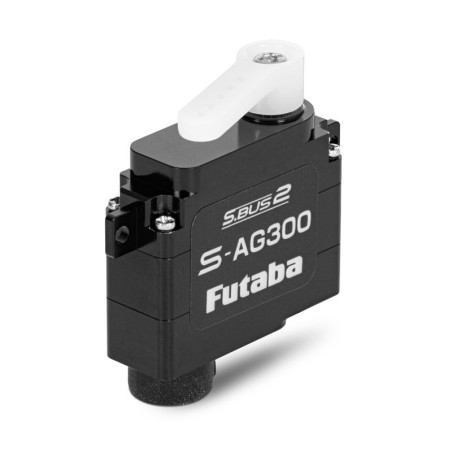


A very powerful and fast programmable S.BUS2/S.BUS digital "picoservo" servo with metal gears and an output shaft mounted on two ball bearings with an extended supply voltage range. To ensure excellent cooling and high mechanical resistance, the servo is housed in an all-metal housing. It is ideal for F3K RC models and similar smaller model gliders and airplanes.
The S-AG300 can be connected to the S.BUS 2 (serial bus with bidirectional communication) or S.BUS (serial bus with unidirectional communication) outputs of receivers, or it can operate as a classic servo connected to the channel (PWM ) output of the receiver.
Using CIU-3 USB interface and S-Link software or Futaba transmitter equipped with S.BUS servo setting function, you can program a whole range of servo parameters (speed, deviation amount, neutral, overload protection , soft start, etc.). Setting the channel for S.BUS2/S.BUS operation is only possible with the transmitter.
Extended supply voltage range 4.8-7.4V (nominal), operating voltage range 3.8-8.4V.
What is S.BUS2/S.BUS
Unlike classic RC kits, the S.BUS(2) system uses serial data communication to send control signals from the receiver to the servo, gyro or other device. This data includes commands such as "move channel 3 servo by 15 degrees, move channel 5 servo by 30 degrees" for many devices. S.BUS(2) devices only execute commands belonging to their own set channel. For this reason, it is possible to connect several servos to the same signal cable, setting and controlling them individually as needed. The servo identification code (ID) is used for this purpose. You can find the ID on a sticker on the servo box.
The S.BUS2 servo can be connected to the receiver's S.BUS2 and S.BUS ports. Its function is determined by setting the channel in the servo's memory (this is done using the programming interface of the Futaba transmitter, the SBC-1 programmer, or the CIU-3 USB interface with the S-Link PC program - for some servos, the channel can only be set using the transmitter).
The S.BUS2 servo connected to the channel output of a classic receiver (PWM) works like a classic servo. Its movement is indicated by a signal in the channel of the receiver to which it is connected. The settings of programmable servo functions remain in effect.
Specifications:
*Follow the instruction manual included with the product